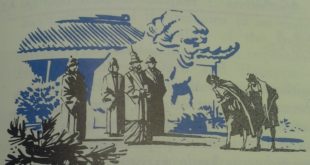In the same way that important ancient civilizations grew out of small beginnings in the valleys of the Nile, the Tigris-Euphrates and the Indus, so another great civilization of Early times — that of China — was cradled in the valley of the Yellow River. To be sure, China’s civilization did not commence as early as did Egypt’s, Mesopotamia’s, or India’s. The ancient Egyptian and the Mesopotamian kingdoms lost their power many centuries ago and early India never became completely united under one empire. China therefore has had a longer national life than any other ancient or modern state. It …
Read More »Tag Archives: Confucius
Borrowing From China A. D. 587 – 838
PRINCE SHOTOKU was pleased to see his fellow aristocrats take to his chosen faith so enthusiastically. He wanted them to adopt other ways of living from China, too. Having seen how the Sui emperors had reunified China after three and a half centuries of disorder, he was particularly eager for Japan to copy their strong central government. In 603 and 604, Shotoku adopted the Chinese calendar, issued a constitution and set up a new civil service system. In the constitution, he left no room for doubt as to the emperor’s supreme position. “A country does not have two lords,” he …
Read More »The Sui and T’ang Restore the Empire A.D. 589-979
IN 589, a warlord named Sui Wen Ti conquered the last dynasty in the south and so became emperor of all China. He put his subjects to work repairing the Great Wall, building palaces and digging long canals to carry water out to the fields and grain back to the cities. He sent his armies south into Vietnam and west into central Asia. In 604, he died. No one knew how he died, but many people suspected that he had been murdered by his son Yang Ti. As emperor, Yang Ti drove the people even harder than his father had. …
Read More »The Six Dynasties: Turmoil and Change A.D. 220-589
THE three states into which China had split were soon split up themselves into even smaller divisions. For three and a half centuries, war raged almost continuously among rival kings. Doubt and confusion were everywhere. The period between 220 and 589 is called the Six Dynasties era, after six ruling families in a row which used Nanking as their capital. In all those years‚ the memory of the Han Empire never died. Looking back longingly at the peace and order of that time, the people came to think of the Han government as the great model which all rulers should …
Read More »China under the Han 206 B. C. – A. D. 221
THE vast East Asian land of China is named after its first family of emperors, the Ch’in. The Ch’in brought the country together under one government and built the Great Wall to keep out northern barbarians. They were in such a hurry to get things done, however, that they drove their subjects too hard and lost their support. In 206 B.C., after only a few years in power, they were overthrown. The Ch’in were replaced by an imperial family named Han. The Han dynasty ruled for two centuries before the time of Christ and then, after a break, for another …
Read More »The Land of the Great Wall 4000 B.C. to A.D. 220
For many generations, the ancestors of P’an Keng had considered themselves kings in northern China. Yet this family of kings, the Shang Dynasty, had never governed from a central capital. About 1380 B. C., P’an Keng decided it was time to set up a capital. He found what seemed to be the perfect site at Anyang. Situated near a bend in China’s Yellow River, the fertile plains were ideal for farming and pasture, while the mountains behind it had timber and wild game. Only one thing remained: P’an Keng had to find out if the move was approved by the …
Read More »




